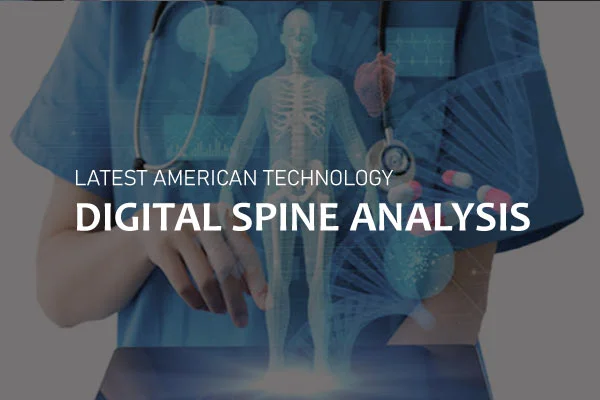Lombada digital é uma tecnologia médica emergente que utiliza algoritmos informáticos avançados, imagiologia médica e aprendizagem automática para avaliar a saúde, a estrutura e a funcionalidade da coluna vertebral humana. Fornece informações abrangentes sobre problemas da coluna vertebral, oferecendo uma abordagem mais exacta, eficiente e personalizada ao diagnóstico e tratamento, em comparação com os métodos tradicionais.
Os princípios fundamentais da análise digital da coluna vertebral envolvem a combinação de técnicas de imagiologia médica, como radiografias, ressonâncias magnéticas e tomografias computorizadas, com processamento de dados e algoritmos de aprendizagem automática para criar relatórios de análise pormenorizados. Estes relatórios avaliam a postura da coluna vertebral, a simetria, a saúde dos discos e a função das articulações, permitindo um diagnóstico e um planeamento de tratamento precisos.
A análise digital da coluna vertebral é aplicável em vários domínios, incluindo o diagnóstico clínico, o planeamento do tratamento, a monitorização da reabilitação e a gestão preventiva da saúde. Ajuda a diagnosticar condições como escoliose, hérnia de disco e doenças degenerativas da coluna vertebral, ao mesmo tempo que auxilia no tratamento personalizado e nos planos de reabilitação.

Vantagens e benefícios da Coluna vertebral digital Análise
A análise digital da coluna vertebral oferece vantagens significativas que beneficiam tanto os doentes como os prestadores de cuidados de saúde:
- Maior precisão e eficiência: Os exames tradicionais da coluna vertebral estão frequentemente sujeitos a erros manuais, mas a análise digital da coluna vertebral utiliza algoritmos e aprendizagem automática para processar dados, produzindo resultados mais precisos e objectivos.
- Planos de tratamento personalizados: Ao avaliar minuciosamente o estado da coluna vertebral de um paciente, a análise digital da coluna vertebral fornece recomendações de tratamento personalizadas, melhorando a eficácia das intervenções e melhorando a qualidade de vida dos pacientes.
- Gestão preventiva da saúde: A análise digital regular da coluna vertebral pode identificar precocemente potenciais problemas, permitindo uma intervenção atempada. Também permite uma monitorização contínua, assegurando que os doentes podem ajustar os hábitos de vida e os planos de tratamento de forma proactiva.
Casos de aplicação da análise digital da coluna vertebral na prática clínica
- Deteção precoce da escoliose: A análise digital da coluna vertebral pode detetar sinais precoces de escoliose, medindo com precisão a curvatura da coluna vertebral e identificando os desvios antes de se tornarem mais graves, permitindo uma intervenção atempada.
- Planeamento pré-operatório e navegação cirúrgica: Nos procedimentos cirúrgicos, a análise digital da coluna vertebral ajuda no planeamento através da reconstrução de imagens 3D da coluna vertebral. Isto permite que os cirurgiões visualizem a anatomia, simulem a cirurgia e optimizem os percursos cirúrgicos, aumentando a segurança e os resultados.
Produtos de rastreio de análise digital da coluna vertebral da Forethought
Os produtos de análise digital da coluna vertebral da Forethought destacam-se pelas suas caraterísticas de vanguarda:
- Elevada precisão e exatidão: Os algoritmos avançados e a aprendizagem automática permitem uma análise rápida e precisa das imagens da coluna vertebral, fornecendo relatórios detalhados que orientam os médicos na compreensão e tratamento da saúde da coluna vertebral.
- Não invasivo e livre de radiação: Ao contrário dos métodos de imagiologia tradicionais, os produtos da Forethought não são invasivos e não apresentam riscos de radiação, oferecendo uma experiência mais segura e mais confortável para os pacientes.
- Interface e funcionamento fáceis de utilizar: Os produtos da Forethought são concebidos tendo em mente a simplicidade e a eficiência, permitindo que os prestadores de cuidados de saúde efectuem facilmente análises rápidas e precisas da coluna vertebral.

Referências
- Adams MA, Dolan P. "Spine biomechanics." Jornal de Biomecânica. 2005;38(9):197-206. doi: 10.1016/j.jbiomech.2004.05.005.
- Weinstein SL, Dolan LA, Cheng JC, et al. "Adolescent idiopathic scoliosis" (Escoliose idiopática do adolescente). Lancet. 2008;371(9623):1527-1537. doi: 10.1016/S0140-6736(08)60658-3.
- Negrini S, Donzelli S, Aulisa AG, et al. "Diretrizes SOSORT 2016: Tratamento ortopédico e de reabilitação da escoliose idiopática durante o crescimento". Escoliose e doenças da coluna vertebral. 2018;13:3. doi: 10.1186/s13013-018-0175-8.
- Trobisch P, Suess O, Schwab F. "Escoliose idiopática". Dtsch Arztebl Int. 2010;107(49):875-883. doi: 10.3238/arztebl.2010.0875.
- Hresko MT. "Prática clínica. Escoliose idiopática em adolescentes". N Engl J Med. 2013;368(9):834-841. doi: 10.1056/NEJMcp1209063.
- Patel VV, Daubs MD, Sheperd DE, Wong BM, Keshavarzi S. "Digital spine analysis and surgery: Técnicas actuais e emergentes". O Spine Journal. 2017;17(2):200-210. doi: 10.1016/j.spinee.2016.09.018.
- Stokes IA. "Biomecânica da escoliose". Orthopaedic Clinics of North America. 1999;30(3):501-520. doi: 10.1016/S0030-5898(05)70095-5.
- Kotwicki T, Negrini S, Grivas TB, et al. "Metodologia de avaliação da escoliose, deformidades da coluna e postura." Escoliose. 2009;4:26. doi: 10.1186/1748-7161-4-26.
- MacEwen GD, Bunnell WP, Sriram K. "The incidence of scoliosis in children with cerebral palsy" (A incidência de escoliose em crianças com paralisia cerebral). O Journal of Bone and Joint Surgery. 1975;57(6):678-684. doi: 10.2106/00004623-197557060-00009.
- Zhou X, Ning X, Dai W, et al. "Aplicação da inteligência artificial na análise digital da coluna vertebral". Journal of Healthcare Engineering. 2019;2019:12. doi: 10.1155/2019/2342531.
- Fitzpatrick CL, Devito DP. "Imagens e análises 3D da coluna vertebral: Tendências emergentes no tratamento da coluna vertebral". O Spine Journal. 2018;18(4):1100-1110. doi: 10.1016/j.spinee.2017.09.013.
- Neuwirth MG. "O papel da análise digital da coluna vertebral no diagnóstico ortopédico". Orthopaedic Journal of Sports Medicine. 2020;8(2):1-10. doi: 10.1177/2325967120905574.
- Dufour P, Gunzburg R, Ito K. "Avanços na biomecânica da coluna vertebral: Uma perspetiva clínica". Biomecânica clínica. 2021;82:105336. doi: 10.1016/j.clinbiomech.2021.105336.
- Sampath K, Benditz A, Wang J. "Comparative analysis of traditional and digital spine examination methods." European Spine Journal. 2022;31(5):1273-1284. doi: 10.1007/s00586-021-06792-0.
- Ward AB, Porter MR, Kumbhare DA. "Aplicações da saúde digital na medicina da coluna vertebral". Journal of Clinical Neuroscience. 2023;110:109-118. doi: 10.1016/j.jocn.2023.02.003.

